French drains are a very common solution to wet yards and foundations we see here in the Charlotte, NC area. Part of the reason there is so much trouble with water in yards is the topography of the land. Being located in the piedmont area of North Carolina (and South Carolina, too), there are quite a few hilly spots. Builders have not always done a great job of setting up neighborhoods with good drainage systems, leaving water to flow into low spots in your yard and puddle.
What are French Drains?
French drains are a way to channel water in your yard underground. Basically, they are a ditch with a pipe and gravel that works to move water away from low lying spots to another area. They act a lot like a storm drain or the gutters on your house, except that the water is moving underground. Older french drains might be a ditch with a pipe and gravel that covers the pipe and is visible on the surface.
Most french drains installed by landscaping construction companies today are a trench filled with gravel and a plastic drain pipe, which may have several visible drains along it, but is mostly covered with grass or wood chips in landscaping bed.
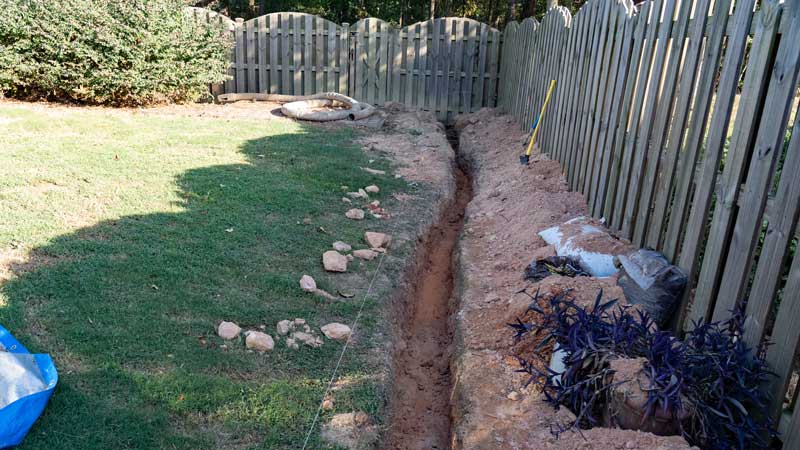
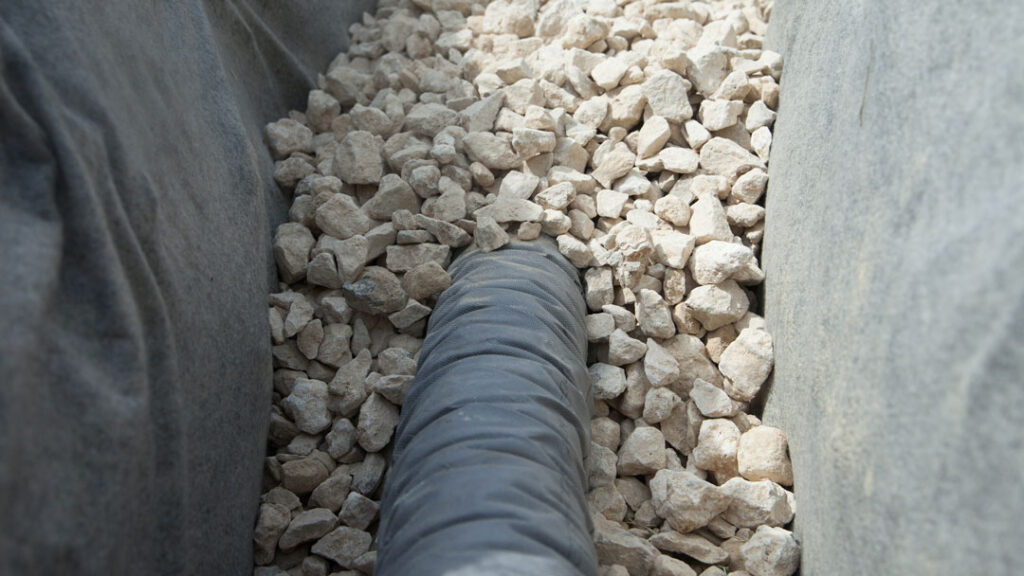
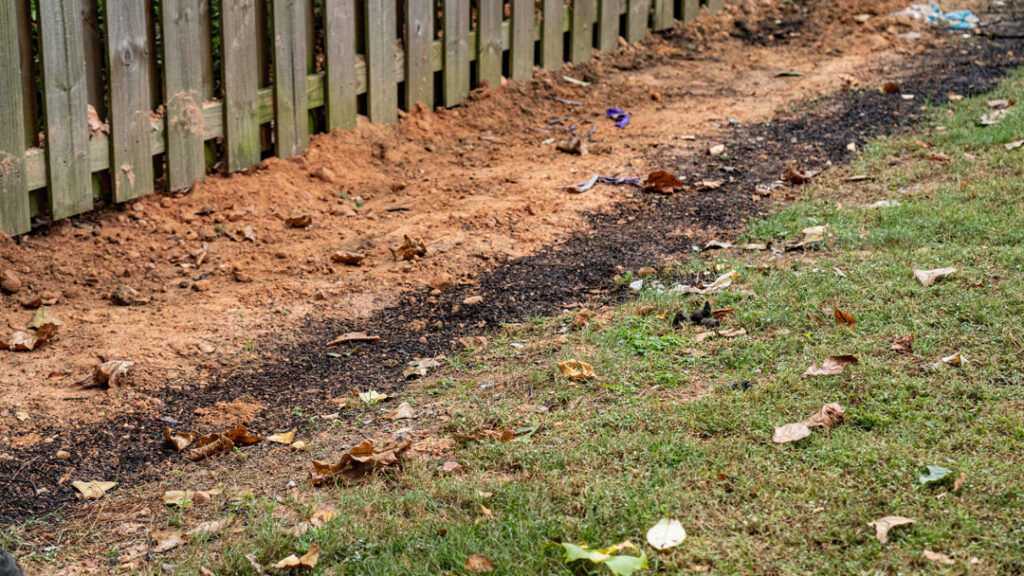
How do French Drains Work?
Whether new or old, the french drain works the same. It uses gravity to channel water away from a low lying area and move it somewhere that it will drain better.
A trench is dug with a slope. It drops about 1 inch for every eight to ten feet in the direction you want the water to move. The trench needs to have a gravel bed to help the water drain and fit a drain pipe, so it will usually need to be 18 to 24 inches deep. The bottom is filled with a couple of inches of gravel, then a perforated pipe is placed in the whole, that is covered by gravel and a top layer of dirt.
Once in place rain and ground water will enter the french drain. When it is raining heavily, the majority of the water will move down the pipe and exit the drain in a better location. This could be a catch basin, a dry well, a detention area or just a better sloped area of your yard that will allow drainage. The rest of the water will leak through holes in the perforated pipe and soak into the ground along the length of the french drain.
Why Use French Drains Around the House?
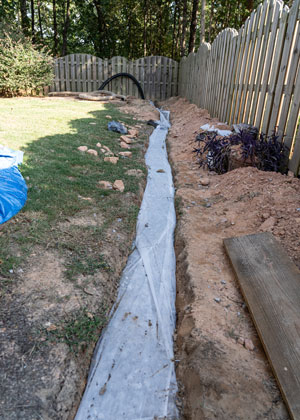
French drains are a very good solution when you have water issues in your crawl space or along your foundation. If there is an area where the water is puddling along the side of the house, then a French drain can be installed to keep this water from sitting against the foundation or puddling in the crawl space and creating flooding issues in the house.
We often see houses built in neighborhoods on hills. The developer or builder has generally terraced the hill to a degree to create somewhat flat lots to build the houses on. Because of the hills in the Charlotte area, that usually means that one side of each house is downhill a few feet from the house next door. It is fairly common that over time, with landscaping changes and natural erosion, the swale area that was supposed to channel water away from the lower sitting house starts to fail. That is when a french drain can help protect that side of the house from water flowing down hill from the neighbors property.
Frequent Questions about French Drains
There are a number of other common questions about french drains that customers ask. Here are some of them to help you determine if a french drain is the right solution for you.
Will a French Drain Work in the Winter?
Here in the Charlotte area, we don’t get very cold winters, so the frost line is only about a foot below the surface. So at 18-24 inches deep, any properly installed french drain will be below the frost line and will work perfectly well in colder temperatures. If you are reading this and live in a colder climate or the North Carolina mountains, then you’d need to make sure that your french drain is installed below the frost line to ensure that there are no problems with it during the winter months.
Do French Drains Fail?
French drains can fail over time, but the most common reason for failure is poor installation. The french drain must be installed with enough slope to move the water. It also needs to be deep enough to be safe and effective. Sometimes french drains are installed without a good outlet for the water to exit, which will cause the water to back up in the drain. When done correctly, the biggest cause of failure in french drains and similar underground water removal techniques is when roots and dirt get into the drain and cause clogs. This is always a risk with underground pipes, even the water and waste pipes that run to and from your house. However, when installed properly, a french drain will last and be effective for a long time, just like those pipes.
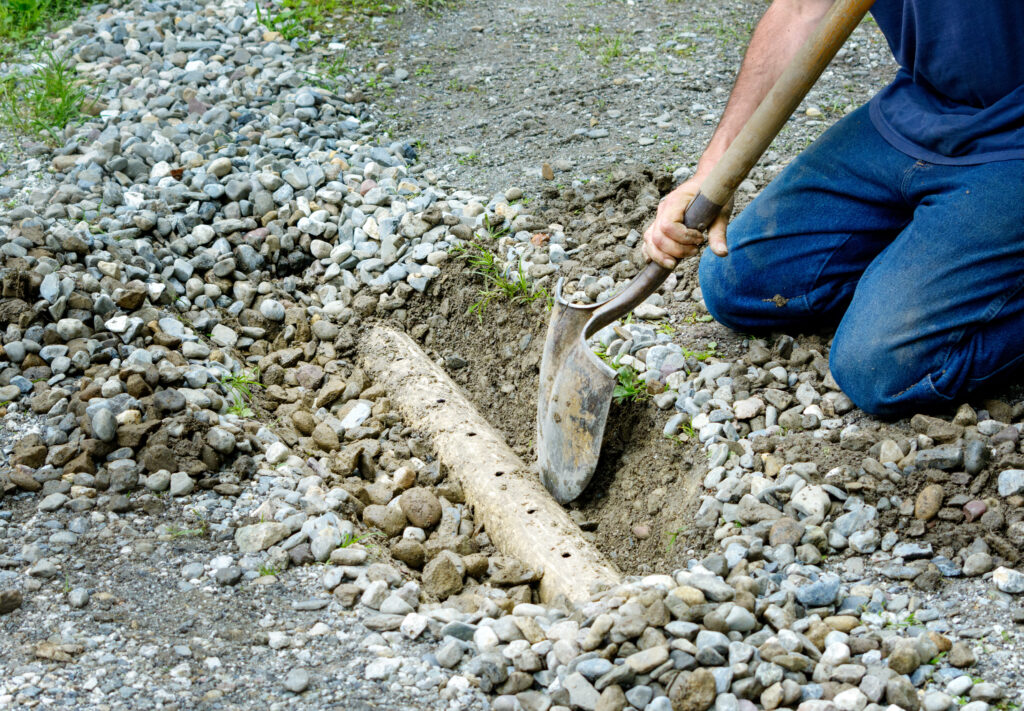
Are French Drains Legal?
You do have to be careful about how the water exists the french drain to make sure that you are not releasing storm water unto a neighboring property illegally. Generally, in North Carolina, if you are making reasonable improvements to your property and it results in increased water runoff to the neighbors, you are protected by law. South Carolina law is a little different and may allow for more diversion of water unto a neighbors property, as long as it doesn’t create a “nuisance.” However, in both states, you wouldn’t want to create an opening of a french drain so that it is pointed right into the neighbors yard because that might be considered unreasonable by a court.
Where Does a French Drain End?
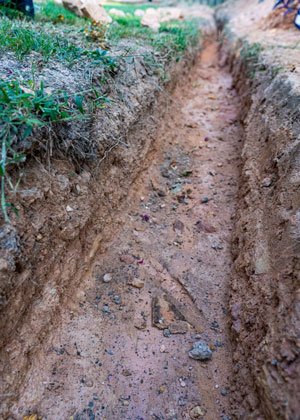
Getting rid of unwanted water at the end of a french drain can be an issue. In most places, you can’t drain the water into the street or tie it directly into a storm water drain. Instead, you have to find a way to remove it from the problem area in your yard and send it someplace else in your yard without causing a flooding issue there. In some cases, you can create a pop-up at the end of the drain, especially if you have a downhill area in your yard. This pop-up releases water when it is flowing in the drain, but hides in the lawn when the drain is dry.
Another option is to end the french drain in a dry well. A dry well is an area in your yard that is dug out and replaced with materials like sand or gravel that allow the water to collect and disperse in a slower fashion than normal soil.
If you have the right situation, you can just terminate the french drain in daylight on a slope. Some people like to use a t-fitting at the end to send the water over a wider drain field, but that often isn’t necessary. As long as the hill disperses the water and it doesn’t create a new standing water issue, then you don’t have to do anything fancy with the end of the french drain. If you are concerned about future problems, you can install some type of critter protection at the open end of the pipe, as well, to keep animals from turning the drain into a home and potentially stopping it up.
Other Drainage Solutions
French drains are just one solution to water problems that may be impacting your foundation or your yard. There are other options when it comes to making sure you can enjoy your yard and safely remove the extra water from areas you don’t want it. We do a lot of drainage work and are known for being able to solve challenging water issues.

